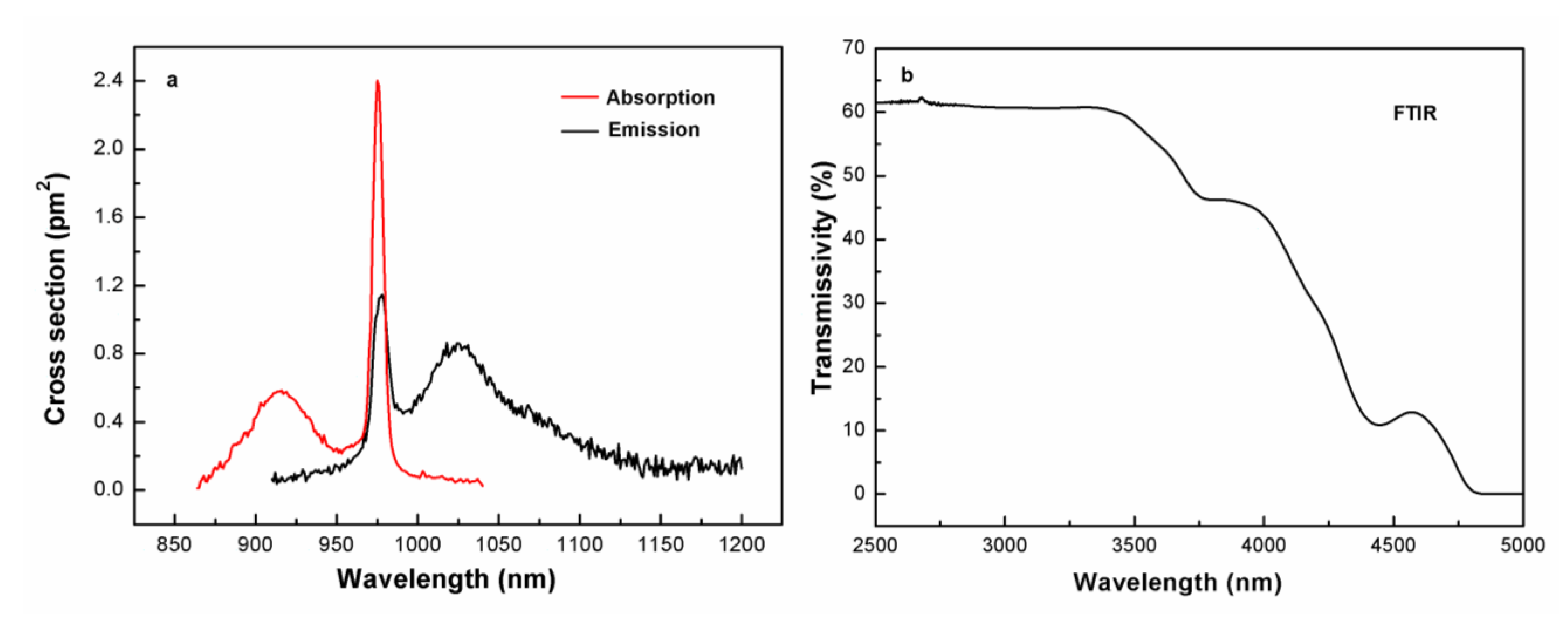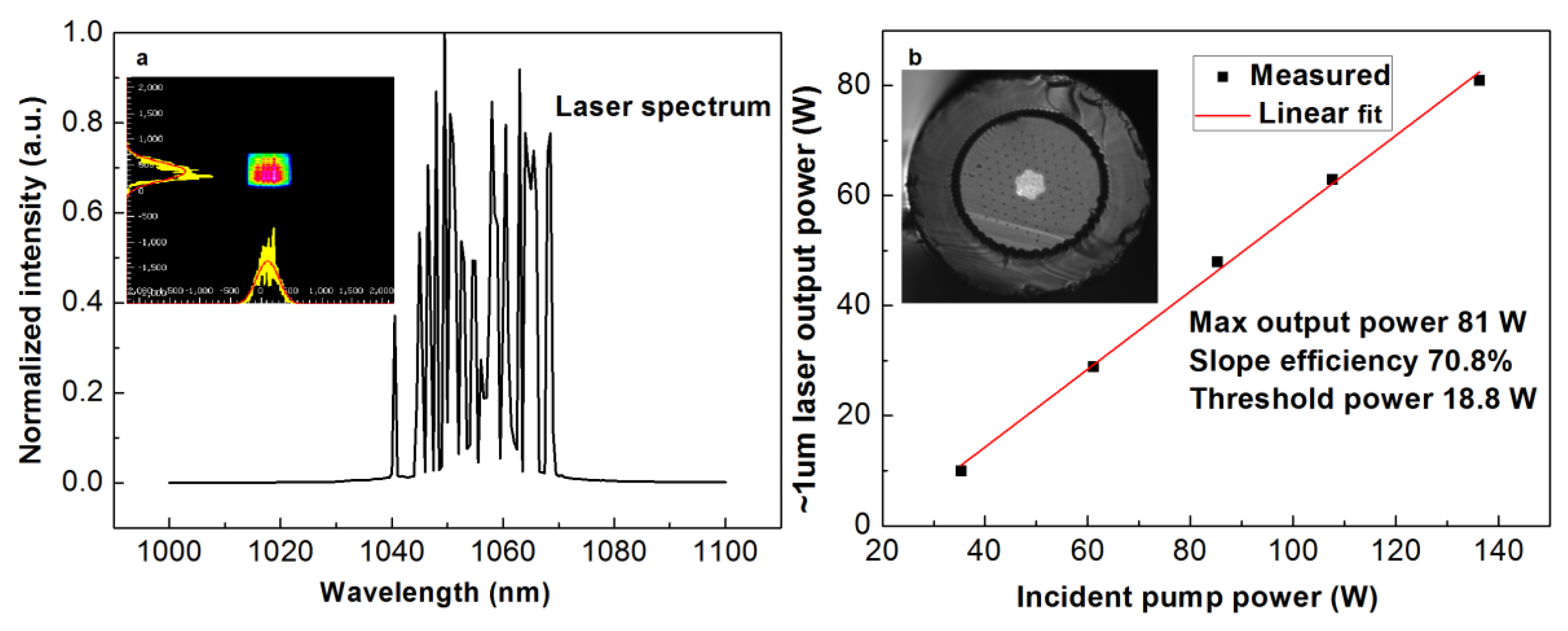Characteristics and Laser Performance of Yb3+-Doped Silica Large Mode Area Fibers Prepared by Sol–Gel Method
Abstract
:1. Introduction
2. Experimental Section

3. Results and Discussion
3.1. Optical Properties of Yb3+-Doped Al2O3–SiO2 Glass

| Preparation Method | Sol-Gel | MCVD | Sol-Gel | Heraeus |
|---|---|---|---|---|
| Yb2O3 (mol%) | 0.1 | 0.15 | 0.21 | 0.25 |
| σabs (976 nm) (pm2) | 2.4 | 2.7 | 1.74 | |
| σemi (~1 µm) (pm2) | 0.8 | ~0.6 | ||
| τ (μs) | 896 | 830 | 840 | |
| OH (ppm) | 1.45 | 0.5 | 2 | |
| Reference | this work | [15,16] | [17] | [18] |
3.2. Optical Loss Profile and Homogeneity of Yb3+-Doped Al2O3–SiO2 Fiber
3.3. Laser Behavior of Yb3+-Doped Al2O3–SiO2 LMA DCF and PCF Fibers



4. Conclusions
Acknowledgments
Conflicts of Interest
References
- Glenzer, S.H.; MacGowan, B.J.; Michel, P.; Meezan, N.B.; Suter, L.J.; Dixit, S.N.; Kline, J.L.; Kyrala, G.A.; Bradley, D.K.; Callahan, D.A.; et al. Symmetric inertial confinement fusion implosions at ultra-high laser energies. Science 2010, 327, 1228–1231. [Google Scholar]
- Galvanauskas, A. High power fiber lasers. Opt. Photon. News 2004, 15, 42–47. [Google Scholar]
- Li, W.; Zhou, Q.; Zhang, L.; Wang, S.; Wang, M.; Yu, C.; Chen, D.; Hu, L. Watt-level Yb-doped silica glass fiber laser with a core made by sol-gel method. Chin. Opt. Lett. 2013, 11, 091601:1–091601:3. [Google Scholar]
- Wei, T.; Li, J.; Zhu, J. Theoretical and experimental study of transient response of the Yb-doped fiber amplifier. Chin. Opt. Lett. 2012, 10, 040605:1–040605:4. [Google Scholar]
- Zhu, R.; Wang, J.; Zhou, J.; Liu, J.; Chen, W. Single-frequency high-energy Yb-doped pulsed all-fiber laser. Chin. Opt. Lett. 2012, 10, 091402:1–091402:4. [Google Scholar]
- Birks, T.A.; Knight, J.C.; Russell, P. St.J. Endlessly single-mode photonic crystal fiber. Opt. Lett. 1997, 22, 961–963. [Google Scholar] [CrossRef]
- Jeong, Y.; Nilsson, J.; Sahu, J.K.; Soh, D.B.S.; Dupriez, P.; Codemard, C.A.; Baek, S.; Payne, D.N.; Horley, R.; Alvarez-Chavez, J.A.; et al. Single-mode plane-polarized ytterbium-doped large-core fiber laser with 633-W continuous-wave output power. Opt. Lett. 2005, 30, 955–957. [Google Scholar]
- Poole, S.B.; Payne, D.N.; Mears, R.J.; Fermann, M.E.; Laming, R.I. Fabrication and characterization of low-loss optical fibers containing rare-earth ions. J. Lightwave Technol. 1986, 4, 870–876. [Google Scholar]
- Dhar, A.; Paul, M.C.; Pal, M.; Mondal, A.K.; Sen, S.; Maiti, H.S.; Sen, R.J. Characterization of porous core layer for controlling rare earth incorporation in optical fiber. Opt. Express 2006, 14, 9006–9015. [Google Scholar] [CrossRef]
- Sen, S.; Rakhmatullin, R.; Gubaydullin, R.; Poppl, A. Direct spectroscopic observation of the atomic-scale mechanisms of clustering and homogenization of rare-earth dopant ions in vitreous silica. Pysical. Rev. B 2006, 74, 100201:1–100201:4. [Google Scholar]
- Wang, S.; Li, Z.; Yu, C.; Wang, M.; Feng, S.; Zhou, Q.; Chen, D.; Hu, L. Fabrication and laser behaviors of Yb3+-doped silica large mode area photonic crystal fiber prepared by sol-gel method. Opt. Mater. 2013, 35, 1752–1755. [Google Scholar]
- Liu, S.; Li, H.; Tang, Y.; Hu, L. Fabrication and spectroscopic properties of Yb3+-doped silica glasses by sol-gel method. Chin. Opt. Lett. 2012, 10, 081601:1–081601:4. [Google Scholar]
- Chen, G.; Zhang, Q.; Yang, G.; Jiang, Z. Mid-infrared emission characteristic and energy transfer of Ho3+-doped tellurite glass sensitized by Tm3+. J. Fluoresc. 2007, 17, 301–307. [Google Scholar]
- Charles, C.R.; Fournier, J.T. Coordination of Yb3+ in some inorganic glasses from optical absorption and emission studies. Chem. Phys. Lett. 1969, 3, 517–519. [Google Scholar]
- Melkumov, M.A.; Bufetov, I.A.; Bubnov, M.M.; Kravtsov, K.S.; Semjonov, S.L.; Shubin, A.V.; Dianov, E.M. Ytterbium lasers based on P2O5- and Al2O3-doped fibers. In Proceedings of the Europeen Conference on Oprical Communication, Stockholm, Sweden, 5–9 September 2004.
- Kirchhof, J.; Unger, S.; Schwuchow, A.; Grimm, S.; Reichel, V. Materials for high-power fiber lasers. J. Non-Cryst. Solids 2006, 352, 2399–2403. [Google Scholar]
- Li, Y.; Huang, J.; Li, Y.; Li, H.; He, Y.; Gu, S.; Chen, G.; Liu, L.; Xu, L. Optical properties and laser output of heavily Yb-doped fiber prepared by sol-gel method and DC-RTA technique. J. Lightwave Technol. 2008, 26, 3256–3260. [Google Scholar]
- Andreas, L.; Gerhard, S.; Mario, S.; Thomas, K.; Volker, R.; Stephan, G.; Johannes, K.; Kraused, V.; Georg, R. A new material for high power laser fibers. Proc. SPIE 2008, 6873, 687311:1–687311:9. [Google Scholar]
- Humbach, O.; Fabian, H.; Grzesik, U.; Haken, U.; Heitmann, W. Analysis of OH absorption bands in synthetic silica. J. Non-Cryst. Solids 1996, 203, 19–23. [Google Scholar]
© 2013 by the authors; licensee MDPI, Basel, Switzerland. This article is an open access article distributed under the terms and conditions of the Creative Commons Attribution license (http://creativecommons.org/licenses/by/3.0/).
Share and Cite
Wang, S.; Lou, F.; Wang, M.; Yu, C.; Feng, S.; Zhou, Q.; Chen, D.; Hu, L. Characteristics and Laser Performance of Yb3+-Doped Silica Large Mode Area Fibers Prepared by Sol–Gel Method. Fibers 2013, 1, 93-100. https://doi.org/10.3390/fib1030093
Wang S, Lou F, Wang M, Yu C, Feng S, Zhou Q, Chen D, Hu L. Characteristics and Laser Performance of Yb3+-Doped Silica Large Mode Area Fibers Prepared by Sol–Gel Method. Fibers. 2013; 1(3):93-100. https://doi.org/10.3390/fib1030093
Chicago/Turabian StyleWang, Shikai, Fengguang Lou, Meng Wang, Chunlei Yu, Suya Feng, Qinling Zhou, Danping Chen, and Lili Hu. 2013. "Characteristics and Laser Performance of Yb3+-Doped Silica Large Mode Area Fibers Prepared by Sol–Gel Method" Fibers 1, no. 3: 93-100. https://doi.org/10.3390/fib1030093




